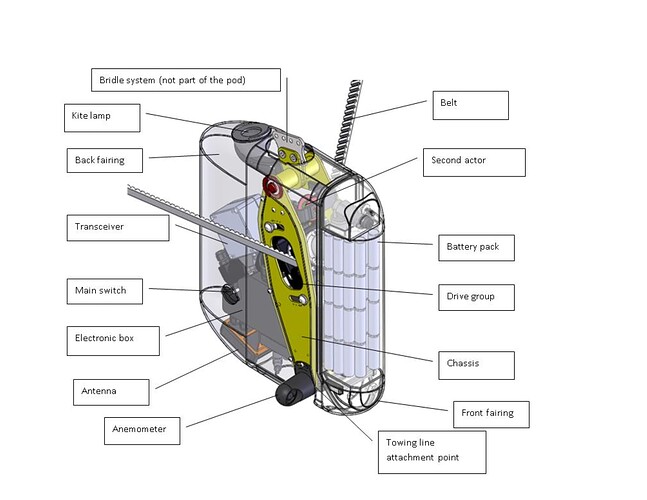The necessity for a tension management system is directly linked to the design of the control pod. Even If the pod can adjust the lengths of the lines individually, the tension control is primarily dictated by the link between the pod and the ground tether anchor point (behind the pod).
Skysails uses a large reel capable of drawing in the line to adjust tension, although this requires energy. This approach has several challenges:
The control pod acts as a connection point for both lines. Thus, any reel tension adjustment impacts both lines, leading to decreased efficiency. A ground-based Control Pod could provide a more direct connection, which may reduce the intermediary steps and enhance tension management efficiency.
On top of that, the significant size and weight of the reel and tethers introduce barriers to rapid tension adjustments. The scale of Skysails’ drum is a notable factor when dealing with fast and agile kites. Such kites, with their swift energy cycles, necessitate that the transmission system rapidly alternate between powering the reel and engaging the generator mode. Moreover, the gearbox must handle large power fluctuations, with peaks potentially reaching thirty times the base power. This on top of the first issue, about how the tension compensation affects both of the control pod’s tethers.
In kite systems, the control pod’s primary function is to adjust the direction of the kite. It achieves this by varying the length of the control lines attached to different points on the kite, much like how a paraglider pilot manipulates the brake lines to turn or change the wing’s shape.
However, the control pod does not have a direct mechanism to alter the tension in the main tether that connects the kite to the ground. This tension is critical for several reasons:
- Response Time: Without the ability to actively manage the tether’s tension, there’s a delay between adjusting the control lines (to change direction) and the kite’s actual movement. This delay arises because the kite’s response is tied to the tether’s tension. It’s comparable to a paraglider pilot, where the pilot’s movements and weight shifts only translate to the wing’s movements when there’s appropriate tension in the brake lines and risers.
- Influence of External Factors: Factors like wind speed and direction, as well as kite speed, play a huge role in determining the tether’s tension. If any of these variables change, it can lead to a change in the tether’s tension, affecting the kite’s behavior and its response to the control pod’s inputs. This dynamic is similar to how a paraglider pilot feels more ‘drag’ or ‘pull’ in stronger winds due to increased tension.
- Lumbering Movement: Because the control pod only manipulates direction and lacks direct control over tension, the kite’s movements can be slower and less precise. It’s similar to how a paraglider might ‘lumber’ or move sluggishly if there’s not enough tension in the lines, making the wing less responsive to the pilot’s inputs.
In so saying, “programing” kite paths using pulses of tension might not be as possible with a Control Pod system because the lines to the kite are so short… The kite would just wiggle
As far as “the speed of sound” goes, even with a direct RF connection to the Control Pod, tension in the line still dictates steering, one would still have to wait for tension to mount in order to see a corresponding change in course, so this actually adds a step.





